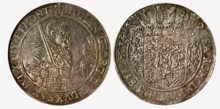
Back Keurvorstedom Sakse Afrikaans Electorau de Saxonia AN انتخابية ساكسونيا Arabic Eleutoráu de Saxonia AST Saksoniya kürfürstlüyü Azerbaijani Курфюрства Саксонія Byelorussian Курфюрство Саксония Bulgarian Priñselezh Saks Breton Electorat de Saxònia Catalan Saské kurfiřtství Czech
Electorate of Saxony | |||||||||||||||||||
|---|---|---|---|---|---|---|---|---|---|---|---|---|---|---|---|---|---|---|---|
| 1356–1806 | |||||||||||||||||||
Coat of arms[a]
| |||||||||||||||||||

The Holy Roman Empire at the 1648 Peace of Westphalia | |||||||||||||||||||
| Status |
| ||||||||||||||||||
| Capital | Wittenberg (1356–1547) Dresden (1547–1806) | ||||||||||||||||||
| Religion |
| ||||||||||||||||||
| Government | Feudal monarchy | ||||||||||||||||||
| Prince-Elector | |||||||||||||||||||
• 1356 | Rudolph I (first) | ||||||||||||||||||
• 1419–1422 | Albert III (last Ascanian) | ||||||||||||||||||
• 1423–1428 | Frederick I (first Wettin) | ||||||||||||||||||
• 1763–1806 | Frederick Augustus III (last) | ||||||||||||||||||
| Historical era | Early modern Europe | ||||||||||||||||||
| 10 January 1356 | |||||||||||||||||||
| 6 January 1423 | |||||||||||||||||||
| 26 August 1485 | |||||||||||||||||||
| 19 May 1547 | |||||||||||||||||||
• Acquired Lusatia by Peace of Prague | 15 June 1635 | ||||||||||||||||||
• Personal union with Poland–Lithuania | 1697–1706 & 1709–63 | ||||||||||||||||||
• Raised to kingdom | 20 December 1806 | ||||||||||||||||||
| |||||||||||||||||||
| Today part of | Germany Poland | ||||||||||||||||||

The Electorate of Saxony, also known as Electoral Saxony (German: Kurfürstentum Sachsen or Kursachsen), was a territory of the Holy Roman Empire from 1356–1806. Its territory included the areas around the cities of Dresden, Leipzig and Chemnitz.
In the Golden Bull of 1356, Emperor Charles IV designated the Duchy of Saxe-Wittenberg an electorate, a territory whose ruler was one of the prince-electors who chose the Holy Roman emperor. After the extinction of the male Saxe-Wittenberg line of the House of Ascania in 1422, the duchy and the electorate passed to the House of Wettin. The electoral privilege was tied only to the Electoral Circle, specifically the territory of the former Duchy of Saxe-Wittenberg.
In the 1485 Treaty of Leipzig, the Wettin noble house was divided between the sons of Elector Frederick II into the Ernestine and Albertine lines, with the electoral district going to the Ernestines. In 1547, when the Ernestine elector John Frederick I was defeated in the Schmalkaldic War, the electoral district and electorship passed to the Albertine line. They remained electors until the dissolution of the Holy Roman Empire in 1806, after which they gained the Saxon kingship through an alliance with Napoleon. The Electorate of Saxony then became the Kingdom of Saxony.
The Electorate of Saxony had a diversified economy and a high level of prosperity, although it suffered major setbacks during and following both the Thirty Years' War of 1618–1648 and the Seven Years' War of 1756–1763. Its middle-class structures were restricted in their development by the nobility and the administration and tended to lag behind contemporary western nations such as the Dutch Republic. Important humanistic and educational impulses came from Saxony through the Reformation that started in the Electorate in the early 1500s. Especially in the 18th century, Saxon culture and arts flourished.
For about 200 years until the end of the 17th century, the Electorate was the second most important territory in the Holy Roman Empire and a key protector of its Protestant principalities. At the time of its greatest extent in 1807 (one year after it was elevated to the status of a kingdom), Saxony had reached a size of 34,994 square kilometers (about 13,500 square miles) and had a population of 2,010,000.[1]
Cite error: There are <ref group=lower-alpha> tags or {{efn}} templates on this page, but the references will not show without a {{reflist|group=lower-alpha}} template or {{notelist}} template (see the help page).
- ^ Whaley, Joachim (2012). Germany and the Holy Roman Empire volume 2: The Peace of Westphalia to the Dissolution of the Reich, 1648–1806. Oxford: OUP Oxford. p. 188.
© MMXXIII Rich X Search. We shall prevail. All rights reserved. Rich X Search


![Coat of arms[a] of Saxony](http://upload.wikimedia.org/wikipedia/commons/thumb/8/8d/Blason_Jean-Georges_IV_de_Saxe.svg/85px-Blason_Jean-Georges_IV_de_Saxe.svg.png)
